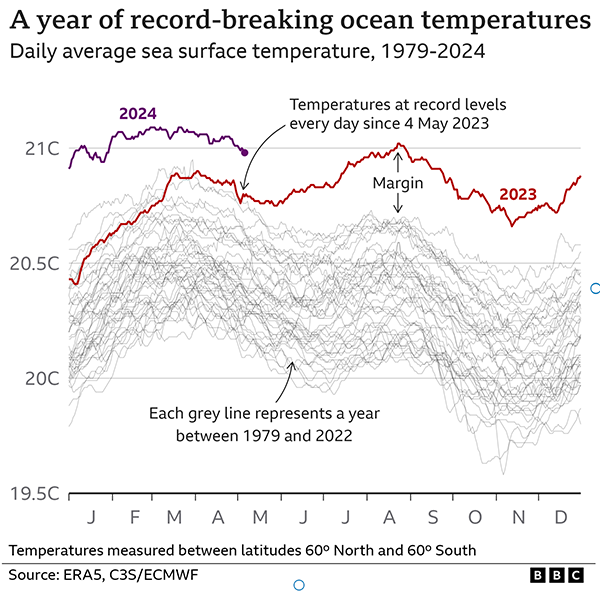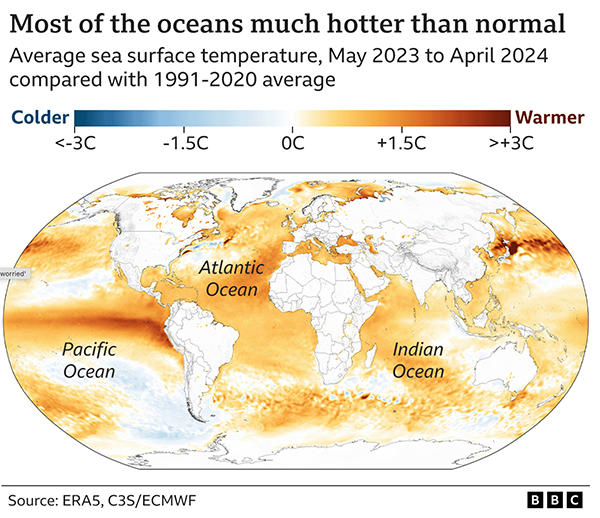
Fuelled by climate change, the world’s oceans have broken temperature records every single day over the past year, a BBC analysis finds. Nearly 50 days have smashed existing highs for the time of year by the largest margin in the satellite era. Planet-warming gasses are mostly to blame, but the natural weather event El Niño has also helped warm the seas. The super-heated oceans have hit marine life hard and driven a new wave of coral bleaching. The analysis is based on data from the EU’s Copernicus Climate Service.
Copernicus also confirmed that last month was the warmest April on record in terms of air temperatures, extending that sequence of month-specific records to 11 in a row.
For many decades, the world’s oceans have been the Earth’s ‘get-out-of-jail card’ when it comes to climate change.
Not only do they absorb around a quarter of the carbon dioxide that humans produce, they also soak up around 90% of the excess heat.
But over the past year, the oceans have displayed the most concerning evidence yet that they are struggling to cope, with the sea surface particularly feeling the heat.
From March 2023, the average surface temperature of the global oceans started to shoot further and further above the long-term norm, hitting a new record high in August.
Recent months have brought no respite, with the sea surface reaching a new global average daily high of 21.09C in February and March this year, according to Copernicus data.
As the graph below shows, not only has every single day since 4 May 2023 broken the daily record for the time of year, but on some days the margin has been huge.

Around 47 days smashed the record for that day of the year by at least 0.3C, according to BBC analysis of Copernicus data.
Never before in the satellite era had the margin of record been this big.
The biggest record-breaking days were 23 August 2023, 3 January 2024 and 5 January 2024, when the previous high was beaten by around 0.34C.
“The fact that all this heat is going into the ocean, and in fact, it’s warming in some respects even more rapidly than we thought it would, is a cause for great concern,” says Prof Mike Meredith from the British Antarctic Survey.
“These are real signs of the environment moving into areas where we really don’t want it to be and if it carries on in that direction the consequences will be severe.”
Huge impact on sea life
This human-driven ocean warming is having considerable impacts on global sea life and may even be shifting the seasonal cycle of sea temperatures, according to according to a recent study.
Perhaps the most significant consequence of the recent warmth has been the mass bleaching of coral globally.

These key ocean nurseries turn white and die because the waters they live in grow too hot. They are a critical element in the ocean ecosystem, home to around a quarter of all marine species.
Unusually warm seas may also have taken a direct toll on one of the most beloved ocean-going creatures in the coldest continent, the emperor penguin.
“There have been examples of the sea-ice collapsing before emperor chicks have properly fledged, and there have been mass drowning events,” says Prof Meredith.
“The emperor penguin is a threatened species because of climate change, and the sea-ice and the ocean temperatures are strongly implicated in that.”
In the UK, rising sea temperatures are having an impact, with a number of creatures having vanished completely from coastal locations – some barnacle species, for example.
“The problem of climate change is that it’s happening too quickly for evolution to catch up with it,” says marine biologist Dr Nova Mieszkowska from the University of Liverpool.
On the Welsh coast, a team from Aberystwyth University use the same technology the police use at a crime scene to track changes in the marine population of Cardigan Bay.
Collecting DNA traces from water samples, they show some invasive species are thriving, including a sea squirt that is believed to have originated in Japan and which grows like a carpet over the sea floor.
“They prevent the growth of native organisms in the areas that they colonise,” says Prof Iain Barber, head of Life Sciences at Aberystwyth University. “Because they do so well in our environment, they can potentially take over huge areas of the seabed.”
Species that are more invasive appear to be responding more strongly to global warming and the increasing water temperatures, Prof Barber says.
The El Niño effect
One important factor that’s made the last year more impactful in seas all over the world has been the El Niño weather phenomenon, adding to human-driven emissions of warming gases.

El Niño sees warmer waters come to the surface of the Pacific. As a result, it tends to push up the global average.
El Niño kicked into gear in June 2023 – after a prolonged period of cooler La Niña conditions – and reached a peak in December, although it has since been fading away.
But other ocean basins that aren’t usually affected by El Niño have also experienced record marine heatwaves – leaving scientists trying to work out exactly what is going on.
“The Atlantic has been warmer than usual, and this is not a pattern you normally associate with El Niño – so it’s something somehow different,” explains Carlo Buontempo, director of Copernicus.
This heat is still persisting in many ocean basins, including the tropical Atlantic.
Warmer seas give tropical storms extra energy, and this could help to fuel a potentially damaging hurricane season.
“There is still a large patch of warmer than usual water in the tropical Atlantic [and] this is the main development region for tropical cyclones,” explains Dr Buontempo.
“We are almost a month ahead in the sea surface temperature in the Atlantic with respect to the annual cycle […] so this is an area that has to be watched.”
As well as these short-term impacts, researchers warn there will be long-term consequences that society will have to adapt to.
For example, ice-sheet melting and deep-ocean warming are likely to continue to fuel sea-level rise in the centuries to come.
“When we talk about climate change, we tend to reduce that to changes on the surface because we live there,” said Angélique Melet, a researcher with Mercator Ocean International.
“However, the deep ocean is one of the aspects [of global warming] that is committing us to centuries and millennia of [climate] change.”
But Dr Melet stresses that is not a reason to give up on cutting emissions.
“Depending on our actions, we can reduce the speed of that warming, and we can decrease the overall amplitude of that warming and sea-level rise.”
Graphics by Erwan Rivault, Muskeen Liddar and Mark Poynting












Social Profiles